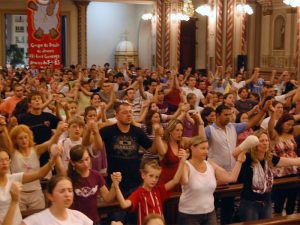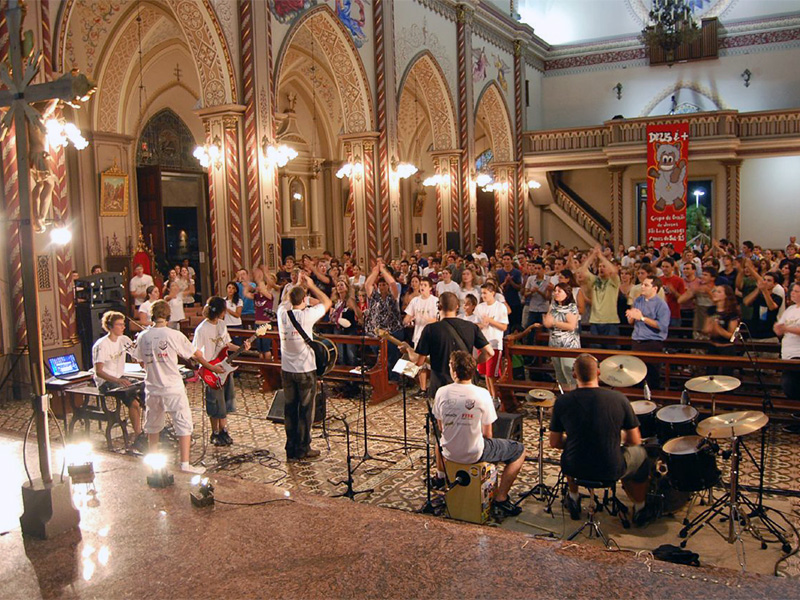
(RNS) This month marks the 50th anniversary of the birth of the most important Catholic lay movement of the past century.
The Catholic Charismatic Renewal ranks second only to Protestant Pentecostalism among significant new Christian movements to emerge over the past century. Like Pentecostalism, the CCR was made in the USA.
At a prayer retreat in a Pittsburgh suburb led by two Duquesne University professors, several students experienced baptism in the Holy Spirit.
From Duquesne, the new Catholic brand of Pentecostalism spread quickly to other universities in the Midwest, such as Notre Dame and Michigan State.
While the CCR remains vibrant today among Latino Catholics in the U.S., Euro-American parishioners haven’t shown much interest in the movement since the 1980s.
In marked contrast, Latin American Catholics have shown great enthusiasm for the movement that was exported to the region by mostly American Jesuit and Dominican priests during the 1970s.
Charismatic Masses and weekend prayer vigils featuring priests who sing and dance to spirited rhythms pack soccer stadiums in Latin America and the Philippines.
The Rev. Marcelo Rossi, a Brazilian CCR priest and a former aerobics instructor, has been one of the rock stars of the movement in Latin America. His books have been best-sellers in nonfiction. His CDs of spirited sacred music have sold millions, and he’s a regular on Brazil’s secular talk shows and in the news media.
Since the 1980s, the Catholic hierarchy from Argentina to Mexico has been in a state of panic over fierce competition from Pentecostalism.
Over the past five decades, tens of millions of predominantly poor Latin Americans have left Catholicism for such Pentecostal denominations as the Brazil-based Universal Church of the Kingdom of God and the gargantuan Assemblies of God. Between losses to charismatic Protestantism and a growing number who adhere to no religion, especially among the region’s millennials, Catholicism in Latin America finds itself at a critical juncture.

A Catholic Charismatic Renewal youth healing service in Brazil in 2009. Photo courtesy of Creative Commons
As recently as 1950, 99 percent of Brazilians were Catholic. According to a recent Pew study, today only 63 percent are Catholic, while the Protestant population has skyrocketed from 1 percent to 22 percent during the same period.
In fact, Pentecostalism has proved so appealing that in my 2003 book, “Competitive Spirits: Latin America’s New Religious Economy,” I described the Christian landscape in Latin America as “pentecostalized.”
With Pentecostalism accounting for approximately 70 percent of all Latin American Protestants and a high percentage of Catholics, those groups that don’t offer Spirit-centered worship largely find themselves on the margins of the region’s Christian landscape.
Evangelization is key to future church growth, yet it has not been the focal point of Pope Francis’ papacy.
Within the global context of competition with Pentecostalism in Latin America, Asia and Africa, evangelization with a preferential option for the poor holds the key to stanching the bleeding and even winning new converts. And no movement within the church has been more successful in revitalizing dioceses and parishes throughout the Global South than the Catholic Charismatic Renewal, which is curiously stagnant in the Global North, not only among Euro-Americans but also among Europeans themselves.
The church’s largest lay movement has also been the catalyst behind the boom in Catholic exorcism over the past few decades, which was thrown into high relief when Francis shocked many by performing an impromptu exorcism on a Mexican parishioner in St. Peter’s Square in late May of 2013.
The Mexican priest who brought the afflicted wheelchair-using parishioner to Rome presented him to the pope as possessed by a legion of demons of abortion.
Since the late 1980s, competition with Pentecostalism has led to the formation of a cadre of Latin American priests affiliated with the CCR who specialize in exorcism (often called “liberation”) ministries.
Such is current parishioner demand for release from demonic possession that some priests, such as Brazil’s Rossi, even celebrate liberation on a weekly basis. Acknowledging his pastoral debt to Brazilian Pentecostal leader Bishop Edir Macedo, whose Universal Church of the Kingdom of God brought exorcism to the fore of Spirit-centered Christianity in Latin America, Rossi stated in an interview that “it was Bishop Edir Macedo who woke us up. He got us up.”
Behind closed doors, CCR lay leaders, predominantly women, also practice unofficial exorcism on believers manifesting symptoms of satanic influence. Many bishops feel such unsanctioned exorcisms are a threat to their ecclesiastical authority and have issued statements denouncing the practice.
In its official statement of approval of the CCR in 1986, the Guatemalan Episcopal Conference referred to “irregularities” with exorcisms and reminded charismatics that only priests with proper episcopal consent can perform the rite.
In one of the most extreme reactions to the practice of unauthorized exorcism, Archbishop Juan Sandoval of Guadalajara, Mexico, excommunicated several members of the Nueva Alianza (New Alliance) CCR covenant community for expelling demons without his approval and also on account of their “Protestant tendency,” which led them, according to the bishop, to ignore the role of the Virgin Mary.
As the CCR has expanded among the working classes of the Global South, demand for physical healing and exorcism has become much greater than in the past.
In the Philippines, where the great majority of Catholics are charismatic, there is even a shortage of trained exorcists, which has led the Archdiocese of Manila to recruit tens of new ones.
Grass-roots charismatics typically implore the Holy Spirit to empower them to overcome such afflictions as alcoholism, unemployment, physical illness, domestic strife and demonic oppression, the latter of which in Brazil and much of the Caribbean often takes the form of possession by the Exús, or liminal trickster spirits of Candomble, Umbanda and other African religions.
Like Francis, Catholic charismatics are very focused on the role of the devil and see his hand in such “vices” as soap operas and drinking.
Exorcism in the CCR, however, has not developed to the point that it has in the Universal Church of the Kingdom of God and other neo-Pentecostal denominations where the demons (in the form of Umbanda or Candomble spirits) are invoked to then be expelled in dramatic fashion by combative pastors.
Beyond exorcism, the CCR rapidly became the largest Catholic lay movement across the world by providing parishioners, especially in the Global South, with a more intimate and spirited form of worship. Before the advent of the CCR, Catholics seeking a more Spirit-centered religious life had few options within the church, and thus many exited for Pentecostalism.
Today, CCR would seem to offer Catholics the best of both worlds: Spirit-centered worship along with the crucial figures of the pope, Virgin Mary and myriad saints. In terms of an evangelization that puts more parishioners in the pews, the CCR stands as the only Catholic lay movement capable of performing such miracles.